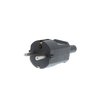Indeed -but there is very little scope for that if one wants to remain compliant with BS1363.Also, some socket plates have the outlet moved higher up towards the top of the accessory in order to accommodate such an appliance plug.
Unless I dreamed it, I think that there is a minimum allowed distance between the earth pin and the edge of the plate - presumably so that it is impossible to insert just the earth pin of an upside-down plug (into the earth receptacle of a socket mounted on a surface box) and thereby open the (unoccupied) L & N shutters (at least, with 'traditional' shutter mechanisms).
Kind Regards, John





